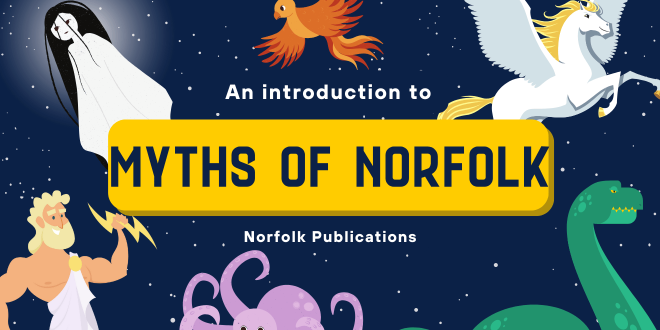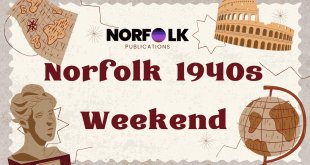Norfolk, with its sweeping coastlines, mysterious woodlands, and medieval cities, has lengthy been a supply of myths, legends, and folklore. Over centuries, tales of ghostly apparitions, mystical creatures, and supernatural occasions have permeated the material of Norfolk’s cultural panorama.
These myths are extra than simply tall tales—they mirror the deep connection between the individuals of Norfolk and the land they inhabit.
Myths of Norfolk

On this article, we are going to discover the fascinating myths of Norfolk, from the notorious Black Shuck, a ghostly canine stated to roam the countryside, to the enchanted Dragon of Ludham, and different lesser-known legends which have formed Norfolk’s folklore.
These tales reveal the county’s wealthy oral custom and its enduring relationship with the supernatural.
1. The Black Shuck: Norfolk’s Ghostly Hound
The Legend
Probably the most well-known myths related to Norfolk is that of the Black Shuck, a large, spectral black canine stated to roam the shoreline and countryside of East Anglia. This legendary creature, with its fiery purple or inexperienced eyes, has been reported in numerous cities and villages throughout Norfolk for hundreds of years. In keeping with legend, seeing the Black Shuck is an omen of demise or misfortune, and those that encounter the beast are stated to be cursed with unhealthy luck.
Essentially the most well-known sighting of the Black Shuck occurred in Bungay and Blythburgh on August 4, 1577. In keeping with studies from that point, the ghostly canine stormed into each St. Mary’s Church in Bungay and Holy Trinity Church in Blythburgh, abandoning a path of destruction. In Bungay, the Shuck was stated to have killed two individuals, whereas in Blythburgh, it left scorch marks on the church door, which may nonetheless be seen as we speak. These occasions cemented the Black Shuck’s place in native folklore.
Learn additionally: 6 Famous Artists and Writers from Norfolk: A Rich Cultural Legacy
Theories and Explanations
Whereas some dismiss the Black Shuck as nothing greater than an exaggerated people story, others imagine that the parable could have originated from sightings of huge, wild canine or wolves that when roamed the countryside. One other principle is that the legend was influenced by Viking mythology, which additionally options tales of ghostly, supernatural canine.
No matter its origin, the Black Shuck continues to seize the creativeness of locals and guests alike. Sightings of the phantom canine persist in Norfolk to today, with some claiming to have glimpsed the Shuck within the misty marshlands or alongside the lonely coastal paths.
2. The Dragon of Ludham
The Legend
Whereas dragons are sometimes related to the myths of faraway lands, Norfolk has its very personal dragon legend centered within the village of Ludham. In keeping with native folklore, a fearsome dragon terrorized the village, destroying crops and livestock. The dragon was stated to reside within the close by marshes, and nobody within the village was courageous sufficient to confront it—till a heroic knight took it upon himself to defeat the beast.
The legend tells of the knight slaying the dragon in an epic battle, with the creature’s physique sinking into the marshes the place it was stated to have resided. Some variations of the story counsel that the dragon’s ghost nonetheless haunts the realm, with locals claiming to listen to eerie sounds emanating from the marshes on quiet nights.
Theories and Symbolism
As with many dragon myths, the Dragon of Ludham could symbolize the forces of chaos and destruction that threatened medieval communities. Dragons in folklore usually signify the unknown and the wild, and this Norfolk legend might mirror the fears of native villagers as they confronted the hazards of illness, famine, and pure disasters.
Whereas there are not any marsh-dwelling dragons in Norfolk as we speak, the legend lives on within the folklore of the county, and Ludham stays probably the most intriguing websites for lovers of native mythology.
3. The Witches of Thetford
The Legend
Norfolk’s connection to witchcraft and superstition is deep-rooted, and probably the most enduring myths is the story of the Witches of Thetford. Within the seventeenth century, in the course of the top of the witch trials throughout England, Thetford grew to become often known as a spot the place witches have been stated to collect and observe darkish magic. Tales circulated of girls accused of utilizing their supernatural powers to forged curses, result in unhealthy harvests, or trigger sickness within the city.
The concern of witchcraft was so intense that a number of girls have been placed on trial in Thetford, with many convicted and executed for witchcraft. These trials have been usually fueled by paranoia and concern, with native superstitions contributing to the unfold of the witch fantasy.
Legacy
The myths of the Witches of Thetford mirror the widespread concern and suspicion of girls, notably those that have been aged, poor, or lived on the margins of society. Whereas these myths have been largely based mostly on superstition and concern, they proceed to be a part of Thetford’s historic narrative. Immediately, guests to Thetford can discover the city’s medieval and early trendy historical past, with the tales of witchcraft remaining an intriguing, if darkish, a part of its cultural heritage.
4. The Pedlar of Swaffham
The Legend
One of many extra light-hearted myths from Norfolk is the story of the Pedlar of Swaffham. This charming story tells of a poor pedlar named John Chapman who lived within the village of Swaffham. One night time, Chapman had an odd dream through which he was instructed to go to London Bridge, the place he would hear some excellent news. Though he initially ignored the dream, it endured, and he finally set off on foot to London.
After ready at London Bridge for a number of days, Chapman was approached by a shopkeeper who requested him why he was there. When Chapman defined his dream, the shopkeeper laughed and instructed him that he, too, had had an odd dream about treasure buried beneath a tree in Swaffham. Chapman instantly returned dwelling, dug beneath the tree, and found a pot of gold. The pedlar’s fortune was made, and he went on to donate cash to the development of Swaffham Church, which nonetheless stands as we speak.
Symbolism and Interpretations
The Pedlar of Swaffham is usually interpreted as a story about religion, endurance, and the rewards of persistence. The story means that following one’s goals—regardless of how unlikely they could appear—can result in sudden fortunes. The parable has endured for hundreds of years and stays a beloved a part of Norfolk’s folklore.
Guests to Swaffham as we speak can nonetheless see the pedlar’s statue within the church, commemorating this native legend and the charitable contributions of John Chapman.
5. Tom Hickathrift: Norfolk’s Large Hero
The Legend
Tom Hickathrift, sometimes called the Large of the Fens, is a legendary determine who is claimed to have lived within the marshy fenlands of Norfolk and Cambridgeshire. In keeping with the parable, Tom was a large of immense power who labored as a laborer within the fens, performing feats of unbelievable bodily energy, akin to shifting enormous stones and uprooting timber.
Essentially the most well-known story related to Tom Hickathrift includes his battle with one other large who terrorized the native space. Armed with solely a cartwheel and an axe, Tom defeated the enormous and have become a hero within the eyes of the native villagers. After his victory, Tom was stated to have develop into a protector of the individuals, utilizing his nice power to carry out acts of bravery and kindness.
Legacy and Symbolism
The legend of Tom Hickathrift is certainly one of Norfolk’s most enduring people tales, and the character of Tom is usually considered as a logo of power, resilience, and loyalty to at least one’s group. Whereas Tom Hickathrift could not have been an actual individual, his story displays the values of rural life in Norfolk and the significance of native heroes.
A number of landmarks in Norfolk are related to the Tom Hickathrift legend, together with Hickathrift’s grave, which might be discovered close to the village of Terrington St John. Guests to the realm can discover these websites and study extra in regards to the large hero’s place in Norfolk’s folklore.
6. The Phantom Coach of East Somerton
The Legend
Deep within the Norfolk Broads, the village of East Somerton is dwelling to certainly one of Norfolk’s eeriest ghost tales: the story of the Phantom Coach. In keeping with native legend, on sure misty nights, a ghostly coach might be seen hurtling down the lanes of East Somerton, pulled by spectral horses and pushed by a mysterious coachman. The coach is claimed to fade as shortly because it seems, leaving no hint of its presence.
Some variations of the story counsel that the coach is carrying a rich nobleman or an area lord, whereas others declare it’s a cursed automobile, doomed to journey ceaselessly via the foggy lanes of Norfolk.
Theories and Sightings
Whereas the story of the Phantom Coach could appear far-fetched, there have been quite a few studies of unusual sightings and unexplained sounds within the East Somerton space over time. Some imagine the legend is rooted in precise historic occasions, whereas others counsel it’s a manifestation of the area’s deep affiliation with demise and the afterlife.
Regardless of the fact behind the parable, the Phantom Coach stays certainly one of Norfolk’s most mysterious and enduring legends.
Conclusion
The myths and legends of Norfolk are as various and colourful because the county itself. From ghostly apparitions just like the Black Shuck to the heroic feats of Tom Hickathrift, these tales provide a captivating glimpse into Norfolk’s wealthy oral custom and its deep connection to the land. Whether or not rooted in historical past or pure creativeness, these myths have been handed down via generations, shaping the id and tradition of the area.
For these enthusiastic about exploring Norfolk’s folklore, the county presents a wealth of alternatives to go to the places related to these legends and study extra in regards to the individuals who first instructed these tales. The myths of Norfolk proceed to seize the creativeness, guaranteeing that the county’s wealthy cultural heritage is preserved for future generations.
 Norfolk Web Publications Web Publications in Norfolk!
Norfolk Web Publications Web Publications in Norfolk!

